SIR 2025
Gastrointestinal Interventions
Scientific Session
Interval Outcomes of Percutaneous Cholangioscopy-Assisted Gallstone Removal in Inoperable Calculous Cholecystitis
.jpg)
Wilton Fidelis
Medical Student
Georgetown University School of Medicine, United States
Neil K. Jain, DO (he/him/his)
Integrated Interventional Radiology Resident
Medstar Georgetown University Hospital, United States
Robin Yoon, BS
Medical student
Georgetown University School of Medicine, United States- DM
Daniel Marchalik, MD
Attending
MedStar Washington Hospital Center, United States 
John B. Smirniotopoulos, MD, MS
Assistant Professor of Radiology
MedStar Georgetown University Hospital, United States
Presenting Author(s)
Author/Co-author(s)
Materials and Methods:
Institutional Review Board (IRB)-approved retrospective study of patients at a large academic center who presented with calculous cholecystitis and were determined to be inoperable surgical candidates from May 2021 to July 2024. Review parameters included procedural technical and clinical data, average hospital length of stay, and post-intervention symptom reduction at follow up intervals of approximately 3, 6, and 12 months. Technical success was defined as the removal of all stones during the procedure. Clinical success was defined by being stone-free on imaging and without recurrent cholecystitis at follow-up.
Results: Forty-one patients (mean age 67.2 years, 39-93 range years; 19 male and 22 female) underwent gallstone extraction assisted by small or large-bore sheath cholangioscopy. The gallstone sizes varied from 0.5 to 4.0 cm. Thirty-eight had previous transhepatic access, while three patients had transperitoneal cholecystostomy access for an average of 75 days (0-786 days) before the gallstone extraction.
All patients had indwelling cholecystostomy tubes before their procedure ranging from 8Fr to 14Fr. Patients had upsize of their access ranging 10Fr to 30Fr depending on operator preference and requirement of scope size as well as lithotripsy device size. Thirty-one patients were under general anesthesia and 10 patients were given conscious sedation. Mean procedure time was 87.8 min (SD 39.1 min) and mean fluoroscopy time was 22.5 min (SD 17.3 min). There was a 100% technical success rate in a single-session stone removal. There were no major intra-procedural complications. 100% were symptom and pain-free post-procedure. Mean hospital stay post-procedure was 1 day. Mean percutaneous gallstone extraction to biliary tube removal time was 38 days (range 0 to 119 days). Of the 41 patients, 17 patients had mean follow-up imaging at 10 months (range 3.5-18.5 months) with US or CT. Zero patients had recurrent cholelithiasis and 0% had recurrent cholecystitis on imaging.
Conclusion: Percutaneous cholangioscopy-assisted gallstone removal is a safe and effective procedure for the destruction of gallstones in patients who are high-risk surgical candidates. All patients that had interval follow-up imaging were found to be stone-free without recurrent cholecystitis after percutaneous fluoroscopic-guided extraction.


.jpg)